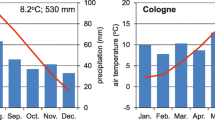Summary
This paper presents a synoptic surface weather map classification scheme, and uses the categorization technique to meteorologically define seasons. Winter is defined as that period of the year in which a location is most frequently poleward of the polar front, while summer occurs when the site is most commonly equatoward. Fall and Spring are the transition periods when, respectively, increasingly more frequent and less frequent periods of time poleward of the polar front occur.
Using 10 years of data, the application of this definition of seasons to the Gulf and Atlantic coasts of the United States is presented. While the frequency of the specific types of major synoptic weather features varied with latitude, the meteorological definitions of season are comparatively invariant with latitude (differing by no more than a month) for this geographic area. Using the meteorological definitions of season, the average winter for this region occurs from late October or early November to late March or early April. Summer is from late May to early June until late August or late September.
Zusammenfassung
Diese Arbeit stellt ein synoptisches Klassifikationsschema nach Bodenwetterkarten vor, das eine Kategorisierungstechnik verwendet, um die Jahreszeiten meteorologisch zu definieren. Der Winter ist als die Periode des Jahres festgelegt, in der ein Ort meist polwärts der Polarfront, während der Sommer jene Periode ist, in der er äquatorwärts der Polarfront liegt. Herbst und Frühjahr sind die Übergangsperioden, in denen zunehmend häufigere bzw. weniger häufige Abschnitte polwärts der Polarfront vorkommen.
Die Anwendung dieser Jahreszeitendefinition wird mit Hilfe der Daten aus 10 Jahren für die Atlantik- und Golfküste der Vereinigten Staaten vorgestellt. Während die Häufigkeiten bestimmter Wetterlagen mit der geographischen Breite schwanken, erwies sich diese meteorologische Jahreszeitendefinition demgegenüber als vergleichbar invariant (mit einem maximalen Unterschied von einem Monat) innerhalb des ausgewählten Gebiets. Der so definierte Winter dieser Region beginnt zwischen Ende Oktober und Anfang November und dauert bis Ende März bzw. Anfang April. Sommer ist zwischen Ende Mai/Anfang Juni und Ende August/Ende September.
Similar content being viewed by others
References
Forbes, G. S., Pielke, R. A., 1985: Use of observational and model-derived fields and regime model output statistics in mesoscale forecasting. Presented at the Nowcasting Symposium at the IAMAP/IAPSO Joint Assembly, August 7, 1985, Honolulu, Hawaii.ESA J., 207–225.
Garstang, M., Nnaji, S., Pielke, R. A., Gusdorf, J., Lindsey, C., Snow, J. W., 1980: Coastal zone wind energy, Part 1. Synoptic and mesoscale controls and distributions of coastal wind energy. DOE Contract DE-AS06-76ET20274, March 1980.
Lindsey, C. G., 1980: Analysis of coastal wind energy regimes. Dept. of Environmental Science, University of Virginia. M.S. thesis.
Lindsey, C. G., Glantz, C. S., 1984: A method to characterize local meteorology for air pollution studies and emergency response needs. Reprint,AMS Fourth Joint Conference on Application of Air Pollution Meteorology, 16–19 October 1984, Portland, Oregon, 260–263.
Lindsey, C. G., Glantz, C. S., 1986: A method to characterize local meteorology at nuclear facilities for application to emergency response needs. Report prepared for the U.S. Nuclear Regulatory Commission, NUREG/CR-3882 PNL-5155, 53 pp.
Pielke, R. A., 1982: The role of mesoscale numerical models in very-short-range forecasting. InNowcasting (ed. K. Browning), New York: Academic Press, pp. 207–221.
Pielke, R. A., Segal, M., Arritt, R. W., Moran, M. D., Yu, C. H., 1986: Effect of local power plant emissions on air quality in Everglades National Park. Report for contract NA81RAH00001, Amendment 17, Item 15, U.S. National Park Service. June, 1986 (in press).
Yu, C.-H., Pielke, R. A., 1986: Mesoscale air quality under stagnant synoptic cold season conditions in the Lake Powell area.Atmos. Environ. 20, 1751–1762.
Author information
Authors and Affiliations
Additional information
With 21 Figures
Rights and permissions
About this article
Cite this article
Pielke, R.A., Garstang, M., Lindsey, C. et al. Use of a synoptic classification scheme to define seasons. Theor Appl Climatol 38, 57–68 (1987). https://doi.org/10.1007/BF00868418
Received:
Revised:
Issue Date:
DOI: https://doi.org/10.1007/BF00868418




